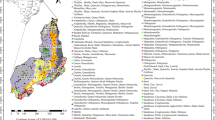Abstract
Purpose
The determination of the contribution of background values in a potentially polluted soil is very important in defining the contamination extension, in particular in areas of geological complexity and long-term economic development, where mining and industry have been traditional activities and soils are showing both geogenic and anthropogenic contributions. Some approaches have been proposed for the estimation of the anthropogenic input vs. the background; in this paper we present a more robust approach.
Materials and methods
The proposed methodological approach includes the following steps. The first step consists of the comparison among the trace element contents in potentially polluted soils (PPS) and the reference and threshold values calculated both for the same geotectonic unit. A second stage is the calculation of the reference and threshold values for the surrounding area (LTV), natural setting, of the PPS with similar lithological characteristics. The final step is based on the analysis of the results by comparison of the PPS with LTV. On the other hand, the definition of a new pollution factor allows to grade the pollution and to classify the pollution importance.
Results and discussion
The protocol proposed was applied to PPS from a potentially polluted area of SW Spain. The anthropogenic vs. geogenic anomalies and the pollution grade of the three PPS were assessed, which is important to establish the priority to further actions. In addition, this study makes clear that the use of the enrichment factors to estimate the pollution of soils is not advisable. On the other hand, in this study, new areas close to the PPS were defined as potentially polluted because of the high trace element concentration.
Conclusions
The methodological approach proposed can be considered as a good indicator for evaluating the geogenic vs. anthropogenic contribution in polluted soils and for classifying the pollution importance in a more robust way than the use of other previous indexes. The proposal methodology could be used also by the administration to detect other PPS in a study area, which a priori were not considered as contaminated.


Similar content being viewed by others
References
Baize D, Sterckeman T (2001) Of the necessity of knowledge of the natural pedogeochemical background content in the evaluation of the contamination of soils by trace elements. Sci Total Environ 264:127–139
Bhuiyan MAH, Parvezb L, Islamc MA, Dampared SB, Suzukia S (2010) Heavy metal pollution of coal mine-affected agricultural soils in the northern part of Bangladesh. J Hazard Mater 173:384–392
Buat-Menard P, Chesselet R (1979) Variable influence of the atmospheric flux on the trace-metal chemistry of oceanic suspended matter. Earth Planet Sci Lett 42:399–411
Castillo S, de la Rosa JD, Sánchez de la Campa AM, González-Castanedo Y, Fernández-Caliani JC, Gonzalez I, Romero A (2013) Contribution of mine wastes to atmospheric metal deposition in the surrounding area of an abandoned heavily polluted mining district (Rio Tinto mines, Spain). Sci Total Environ 449:363–372
Chopin EIB, Alloway BJ (2007) Trace element partitioning and soil particle characterisation around mining and smelting areas at Tharsis, Ríotinto and Huelva, SW Spain. Sci Total Environ 373:488–500
Fernández-Caliani JC, Barba-Brioso C, González I, Galán E (2009) Heavy metal pollution in soils around the abandoned mine sites of the Iberian Pyrite Belt (Southwest Spain). Water Air Soil Pollut 200:211–226
Galán E, Fernández-Caliani JC, González I, Aparicio P, Romero A (2008) Influence of geological setting on geochemical baselines of trace elements in soils. Application to soils of South-West Spain. J Geochem Explor 98:89–106
González I, López M, Romero A (2008) Problemática de los suelos afectados por la explotación de sulfuros. Macla 10:61–75
González I, Galán E, Romero A (2011) Assessing soil quality in areas affected by sulphide mining. Application to soils in the Iberian Pyrite Belt (SW SPAIN). Minerals 1:73–108
Hakanson L (1980) An ecological risk index for aquatic pollution control, a sediment logical approach. Water Res 14:975–1001
López M, González I, Romero A (2008) Trace elements contamination of agricultural soils affected by sulphide exploitation (Iberian Pyrite Belt, SW Spain). Environ Geol 54:805–818
Loska K, Cebula J, Pelczar J, Wiechula D, Kwapuliński J (1997) Use of enrichment, and contamination factors together with geoaccumulation indices to evaluate the content of Cd, Cu, and Ni in the Rybnik Water Reservoir in Poland. Water Air Soil Pollut 93:347–365
Loska K, Wiechuła D, Korus I (2004) Metal contamination of farming soils affected by industry. Environ Int 30:159–165
Müller G (1969) Index of geoaccumulation in sediments of the Rhine River. GeoJournal 2:108–118
Plumlee G (1994) Environmental geology models of mineral deposits. SE Newslett 16:5–6, January
Reimann C, de Caritat P (2005) Distinguishing between natural and anthropogenic sources for elements in the environment: regional geochemical surveys versus enrichment factors. Sci Total Environ 337:91–107
Salminen R, Tarvainen T (1997) The problem of defining geochemical baselines. A case study of selected elements and geological materials in Finland. J Geochem Explor 60:91–98
Sánchez de la Campa AM, de la Rosa J, Fernández-Caliani JC, González-Castanedo Y (2011) Impact of abandoned mine waste on atmospheric respirable particulate matter in the historic mining district of Rio Tinto (Iberian Pyrite Belt). Environ Res 111:1018–1023
Schermerhörn LJG (1971) An outline stratigraphy of the Iberian Pyrite Belt. Bol Geol Min 86:239–268
Sterckeman T, Douay F, Baize D, Fourrier H, Proix N, Schvartz C (2006) Trace elements in soils developed in sedimentary materials from Northern France. Geoderma 136:912–929
Sutherland RA (2000) Bed sediment-associated trace metals in an urban stream, Oahu, Hawaii. Environ Geol 39:611–627
Tarvainen T, Kallio E (2002) Baselines of certain bioavailable and total heavy metal concentrations in Finland. Appl Geochem 17:975–980
Author information
Authors and Affiliations
Corresponding author
Additional information
Responsible editor: Claudio Bini
Rights and permissions
About this article
Cite this article
Galán, E., González, I., Romero, A. et al. A methodological approach to estimate the geogenic contribution in soils potentially polluted by trace elements. Application to a case study. J Soils Sediments 14, 810–818 (2014). https://doi.org/10.1007/s11368-013-0784-1
Received:
Accepted:
Published:
Issue Date:
DOI: https://doi.org/10.1007/s11368-013-0784-1




